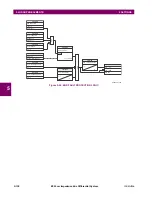
GE Multilin
B90 Low Impedance Bus Differential System
5-121
5 SETTINGS
5.5 GROUPED ELEMENTS
5
STAGE 3: OUTPUT
The outputs from the scheme are:
•
FlexLogic operands that report on the operation of portions of the scheme
•
FlexLogic operand used to re-trip the protected breaker
•
FlexLogic operands that initiate tripping required to clear the faulted zone. The trip output can be sealed-in for an
adjustable period.
•
Target message indicating a failed breaker has been declared
•
Illumination of the face plate TRIP LED
BREAKER FAILURE SETTINGS:
•
BF1 INITIATE
: This setting selects the FlexLogic operand that initiates three-pole tripping of the breaker. Although this
scheme is designed for three-pole tripping, it can be used with single-pole tripping schemes if the hiset and loset cur-
rent elements are set to be sensitive to the lowest expected fault value but insensitive to the highest expected load on
the protected line.
•
BF1 USE AMP SUPV
: If set to "Yes", the element will only be initiated if current flowing through the breaker is above
the supervision pickup level.
•
BF1 USE SEAL-IN
: If set to "Yes", the element will only be sealed-in if current flowing through the breaker is above the
supervision pickup level.
•
BF1 AMP SUPV OP A through C
: This setting selects the B90 Remote Inputs that represent operation of the current
supervision elements on phase A, B, or C.
•
BF1 USE TIMER 1
: If set to "Yes", the Early Path is operational.
•
BF1 TIMER 1 PICKUP DELAY
: Timer 1 is set to the shortest time required for breaker auxiliary contact BKR POS1 to
open, from the time the initial trip signal is applied to the breaker trip circuit, plus a safety margin
•
BF1 USE TIMER 2
: If set to "Yes", the Main Path is operational.
•
BF1 TIMER 2 PICKUP DELAY
: Timer 2 is set to the expected opening time of the breaker, plus a safety margin. This
safety margin was historically intended to allow for measuring and timing errors in the breaker failure scheme equip-
ment. In microprocessor relays this time is not significant. In UR relays, which use a Fourier transform, the calculated
current magnitude will ramp-down to zero one power frequency cycle after the current is interrupted, and this lag
should be included in the overall margin duration, as it occurs after current interruption. The
Breaker Failure Main Path
Sequence
diagram shows a margin of two cycles; this interval is considered the minimum appropriate for most applica-
tions.
In bulk oil circuit breakers, the interrupting time for currents less than 25% of the interrupting rating can be sig-
nificantly longer than the normal interrupting time.
•
BF1 USE TIMER 3
: If set to "Yes", the Slow Path is operational.
•
BF1 TIMER 3 PICKUP DELAY
: Timer 3 is set to the same interval as Timer 2, plus an increased safety margin.
Because this path is intended to operate only for low level faults, the delay can be in the order of 300 to 500 ms.
•
BF1 BKR POS1
: This setting selects the FlexLogic operand that represents the protected breaker early-type auxiliary
switch contact (52/a). This is normally a non-multiplied Form-A contact. The contact may even be adjusted to have the
shortest possible operating time.
•
BF1 BKR POS2
: This setting selects the FlexLogic operand that represents the protected breaker normal type auxil-
iary switch contact (52/a). This may be a multiplied contact.
•
BF1 BKR TEST ON
: This setting selects the FlexLogic operand that represents the breaker In-Service/Out-of-Service
switch, set to the Out-of-Service position.
•
BF1 LOSET TIME DELAY
: This setting represents the pickup delay for current detection after opening resistor inser-
tion. Typically this is based on the time while the breaker resistor current can flow through the circuit after the breaker
interrupting time.
•
BF1 TRIP DROPOUT TIME DELAY
: This setting is used to set the period of time for which the trip output is sealed-in.
This timer must be coordinated with the automatic reclosing scheme of the failed breaker, to which the breaker failure
NOTE
Summary of Contents for B90
Page 10: ...x B90 Low Impedance Bus Differential System GE Multilin TABLE OF CONTENTS ...
Page 284: ...5 166 B90 Low Impedance Bus Differential System GE Multilin 5 8 TESTING 5 SETTINGS 5 ...
Page 334: ...10 8 B90 Low Impedance Bus Differential System GE Multilin 10 2 BATTERIES 10 MAINTENANCE 10 ...
Page 338: ...A 4 B90 Low Impedance Bus Differential System GE Multilin A 1 PARAMETER LISTS APPENDIX A A ...
Page 460: ...C 30 B90 Low Impedance Bus Differential System GE Multilin C 7 LOGICAL NODES APPENDIX C C ...
Page 476: ...E 10 B90 Low Impedance Bus Differential System GE Multilin E 1 IEC 60870 5 104 APPENDIX E E ...
Page 502: ...viii B90 Low Impedance Bus Differential System GE Multilin INDEX ...
















































